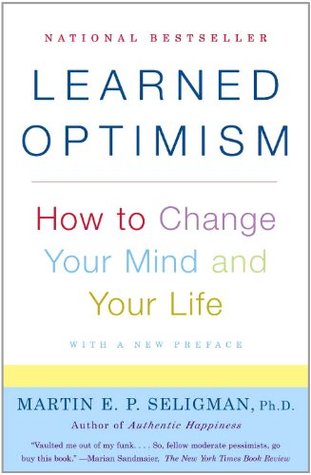More on this book
Community
Kindle Notes & Highlights
Read between
October 16, 2017 - May 2, 2018
unusually well, and you help the client rid herself of depression, anxiety, and anger, happiness is not guaranteed.
For the “Pleasant Life,” you aim to have as much positive emotion as possible and learn the skills to amplify positive emotion.
For the “Engaged Life,” you identify your highest strengths and talents and recraft your life to use them as much as you can in work, love, friendship, parenting, and leisure. For the “Meaningful Life,” you use your highest strengths and talents to belong to and serve something you believe is larger than the self.
Why is it that in a nation that has more money, more power, more records, more books, and more education, that depression should be so much more prevalent than it was when the nation was less prosperous and less powerful?
depression is a disorder of the “I,” failing in your own eyes relative to your goals.
In a society in which individualism is becoming rampant, people more and more believe that they are the center of the world.
Such a belief system makes individual failure alm...
This highlight has been truncated due to consecutive passage length restrictions.
The Little Engine That Could. It is about doing well in the world, about persisting and therefore overcoming obstacles. Now many children’s books are about feeling good, having high self-esteem, and exuding confidence.
Self-esteem seems only to be a symptom, a correlate, of how well a person is doing in the world.
that their unwarranted self-esteem causes violence. Baumeister’s work suggests that if you teach unwarrantedly high self-esteem to children, problems will ensue.
When these children confront the real world, and it tells them they are not as great as they have been taught, they will lash out with violence.
boosting self-esteem is not the answer to curbing the epidemic of depression,
We are also not going to do therapy with an entire generation, because there are simply not enough good therapists to go around.
She, on the other hand, sees bad events in their least threatening light.
The defining characteristic of pessimists is that they tend to believe bad events will last a long time, will undermine everything they do, and are their own fault.
They tend to believe defeat is just a temporary setback,
The optimists believe defeat is not their fault: Circumstances, bad luck, or other people brought it about.
Such people are unfazed ...
This highlight has been truncated due to consecutive passage length restrictions.
Confronted by a bad situation, they perceive it as a challe...
This highlight has been truncated due to consecutive passage length restrictions.
Literally hundreds of studies show that pessimists give up more easily and ge...
This highlight has been truncated due to consecutive passage length restrictions.
Their health is unusually good. They age well, much freer than most of us from the usual physical ills of middle age.
pessimism is escapable. Pessimists can in fact learn to be optimists,
AT THE CORE of the phenomenon of pessimism is another phenomenon—that of helplessness.
Personal control means the ability to change things by one’s voluntary actions; it is the opposite of helplessness.
The way we think about this realm of life can actually diminish or enlarge the control we have over it. Our thoughts are not merely reactions to events; they change what ensues.
But twenty-five years of study has convinced me that if we habitually believe, as does the pessimist, that misfortune is our fault, is enduring, and will undermine everything we do,
Pessimistic prophecies are self-fulfilling.
The Freudians held that unresolved childhood conflicts drove adult behavior.
depression, the ultimate expression of pessimism.
Severe depression is ten times more prevalent today than it was fifty years ago.
He claimed that depression was anger turned against the self: The depressive disparages himself as worthless and wants to kill himself.
Self-loathing, depression as a reaction to loss, suicide—all follow neatly.
In more than 90 percent of cases, depression is episodic: It comes and then it goes. The episodes last between three and twelve months.
Although many thousands of patients have had hundreds of thousands of sessions, psychoanalytic therapy has not been demonstrated to work for depression.
The antidepressant drugs are as good an example of our overmedicated society as the use of tranquilizers to bring peace of mind or hallucinogens to see beauty.
In each case, emotional problems that could be solved by one’s own skills and actions are turned over to an outside agent for solution.
What if depression is in fact set off by present troubles?
What if depression arises from mistaken inferences we make from the tragedies and setbacks we all experience over the course of a life?
Pumping-up seminars work for a few days or weeks, then more pumping up is needed.
Changing the destructive things you say to yourself when you experience the setbacks that life deals all of us is the central skill of optimism.
see events as successes or failures of personal control.
Learned helplessness is the giving-up reaction, the quitting response that follows from the belief that whatever you do doesn’t matter.
An optimistic explanatory style stops helplessness,
Each of us carries a word in his heart, a “no” or a “yes.”
pessimism is not fixed and unchangeable.
helplessness could be learned, and therefore unlearned.
most human beings, as well as household pets, are alive today because animal experiments were carried out. Without them, he asserted, polio would still be rampant and smallpox widespread.
scientists often get caught up in their own ambitions and conveniently forget the ideals they had when they started out.
the dog that had found that nothing it did mattered made no effort to escape,
animals can learn their actions are futile, and when they do, they no longer initiate action; they become passive.


